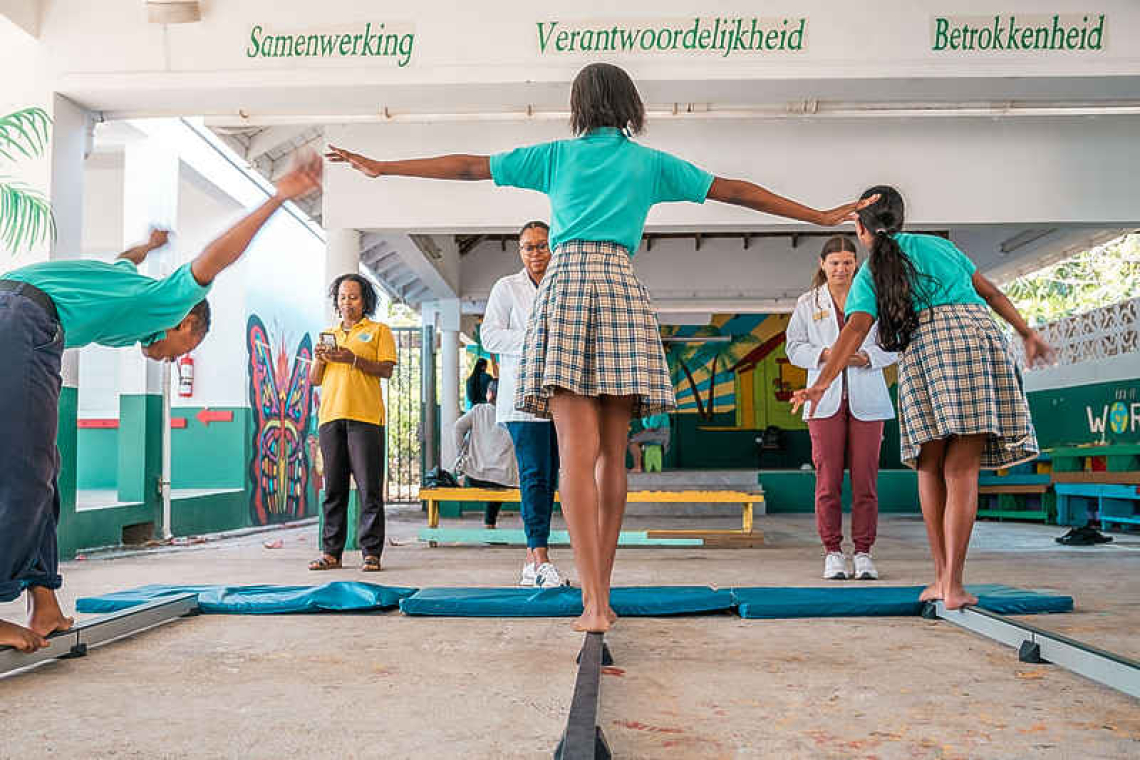American University of the Caribbean students conducting the BLOC test on primary schoolchildren. (Photo courtesy Andre Knol/Stichting EGO)
PHILIPSBURG--The final results of two comprehensive studies into the lifestyles and motor skills of children in St. Maarten was presented by Stichting Expertisecentrum Ervaringsgericht Onderwijs (EGO) Foundation representatives to a broad cross-section of persons working in public education and the school sector, at the Government Building, Philipsburg, on Monday.
Among the around 30 attendees present, prominent names included Minister of Public Health, Social Development and Labor VSA Richinel S.J. Brug, Division Head of Public Education Daison Marks, Section Head of health services at Collective Prevention Services (CPS) Maria Henry and National Sports Institute (NSI) Director Jisk Goslinga.
Government Sports Department Head Jonelle Richardson, Dr. Nathalie Humphrey from American University of the Caribbean Medical School (AUC) community engagement department, EGO board member Jelle Hamstra, and Eelco Boomsma, Head of the Dutch Mission of Representation in St. Maarten.
The study was carried out in collaboration with St. Maarten Development Fund (SMDF), Department of Collective Prevention Services (CPS) and Department of Sports, with research funded by representation of the Netherlands in Aruba, Curaçao, and St. Maarten, Collective Prevention Services (CPS) and JOGG (Youth Unhealthy Weight).
The research was conducted at 17 primary schools on St. Maarten, following a pilot study with six participating schools, and provides valuable insight into children’s lifestyles. Importantly, results will contribute to shaping new government policy for the future. The data disclosed on the various topics on Monday was not previously available in St. Maarten. All public and Catholic schools were included.
More than 3,500 children were assessed using the BLOC Test developed by HAN University of Applied Studies while 1,876 fully completed questionnaires from parents of children ages 4-12 years were analysed through Child Monitor, a lifestyle intervention survey developed by the Mulier Institute, a scientific research agency in the Netherlands.
The Child Monitor survey was completed by parents and contained questions about their child’s lifestyle and behaviour in the following areas: eating, drinking, oral hygiene, playing, screen time, sleep, travelling to and from school, and exercise during and after school.
The BLOC Test is a physical test performed by the children themselves. The child’s movement skills are tested under categories such as balancing, sideways jumping, lateral movement and eye-hand coordination. The four tests measure coordinate ability, and permit researchers to track individuals, schools and classes, year after year.
The data is provided by age group and schools separately. Results show the areas where improvement or change is needed for the child.
The presentation was given by Juriaan Otto, a former Physical Education (PE) teacher in St. Maarten, now Stichting EGO representative and Project Leader Healthy Schools and Communities. EGO representative Ria Uiterloo gave the welcome and introduction.
When he embarked on this project two years ago, Otto said, his mission was “to get children playing and moving more,” knowing that this is not easy in St. Maarten.
He recalled his time as PE teacher seeing children with low energy, sleeping during class, and the food options, almost always unhealthy (fried food), as reasons that motivated him to start the project to collect data.
Uiterloo said the goal is to give all children in St. Maarten, not just the privileged, access to movement opportunities and activities that may not have been available to them before.
Researchers Nina Derix and Maaike Heerschop from the Mulier Institute provided input on the results via video link during the presentation.
BLOC Test results:
Some 63 per cent of St. Maarten children scored “under average” for movement skills. Results from Saba and Statia and in the Netherlands were comparable. In age groups, younger children move better than older children, the figures show. The reason for older children not moving as much can be attributed to academic pressure.
Younger children want to go outside to play and explore, while older children are beginning to discover screens and gadgets and are starting schoolwork. Lack of movement can also be attributed to lack of facilities in the schools.
“We know that some schools don’t have a PE teacher, some schools don’t have a gym, and some schools don’t have enough equipment. This can be a reason for the difference in how schools attach importance to either activities or academics,” Otto offered.
Some 8% of children were excellent movers. This is interesting information for talent scouts to tap into, as those children may well develop into becoming future top athletes or Olympians.
Child Monitor study from the questionnaires:
In the Child Monitor study, results were analysed by school group and gender. The mean age of children was 8.7 years old, 52% were girls and 48% boys. The educational level of parents was varied. Most parents finished secondary education (17%). After that most parents finished university.
General health and happiness:
In general, parents found their child to be very healthy (77%), One in five parents found their child reasonably healthy (21%). Very few parents (2%) found their child unhealthy. Most parents (88%) indicated their children are happy or very happy.
On the question of who is most responsible for a child’s health, most parents said it is the parents themselves who are most responsible. The child itself and the government were least responsible.
Hours of sleep per night:
Children sleep 8.8 hours per night on average. Most children sleep between six and nine hours per night (73%), A quarter of children sleep between 9 and 12 hours per night (25%). The majority of parents thought their child gets enough sleep (72%).
One in five children has trouble sleeping (21%). The most common problem is the child not wanting to go to bed (9%), trouble falling asleep (6%), and waking up during the night (5%).
Drinking habits:
Half of the children drink four to five or more glasses of water per day (53%). More than half of children consume either no sugary drinks or less than one glass a day. The vast majority of children do not or barely consume sugar-free drinks (87%). Most parents think their children drink enough water (66%).
Eating habits:
Most children eat breakfast every day (79%). A very small percentage (2%) never eat breakfast. One third of children eat fruit every day (35%) and one in five eat vegetables every day (21%). The World Health Organisation (WHO) recommends a daily breakfast and 400 grams or five portions of fruit and vegetables per day. 52% of parents believe their child is a healthy eater.
Oral hygiene:
The majority of children brush their teeth at least two times a day (71%). Almost a quarter of children brush their teeth once a day (23%).
Sports practised by children:
The sport in which most children participate is swimming (50%), followed by soccer (32%) and dancing (21%). One in five children play outside less than one day a week (21%). A quarter of children play outside every day (23%).
“About playing opportunities outside, many parents think there is not enough variety in play areas, and that play areas do not match what a child wishes,” noted Maaike Heerschop. “We also see that parents worry that their child cannot play safely outside because of heavy traffic.”
Screen Time:
The average screen time of children is three hours per day. Half of the children watch television, movies or series every day (44%). Almost a third spend time on a smartphone daily (28%) and one in five children play electronic games daily (27%). Screen time also increases as the child gets older.
Health at school:
Two thirds of parents (61%) think schools should pay attention to exercise. Most parents (51%) find it important for schools to address healthy nutrition. Mental health and well-being are also important for schools to pay attention to.
“Now that we have the data, it is time for action,” said Otto. “That should start with an awareness campaign everywhere on eating habits. Secondly, reduce the consumption of sugary drinks (juices and sodas). Third, provide healthy eating options in the canteen. In conjunction with AUC we have created some movement videos, and just for a few minutes every day doing this exercise should be compulsory in schools.”
The presentation concluded with a question and answer session with the presenters.







